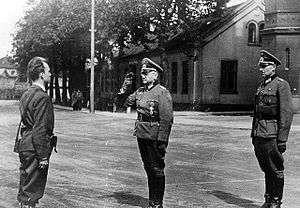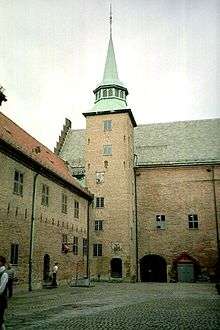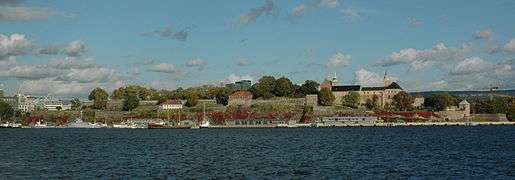Akershus Fortress
| Akershus slott og festning Castle and Fortress | |
|---|---|
| Oslo, Norway | |
|
Akershus Castle and Fortress | |
| Site information | |
| Controlled by | Norway |
| Site history | |
| Built | 1290s |
| In use | 1290s–present |
| Materials | Stone |
Akershus Fortress (Norwegian: Akershus Festning) or Akershus Castle (Norwegian: Akershus slott) is a medieval castle that was built to protect Oslo, the capital of Norway. It has also been used as a prison.
Construction
It is not known exactly when the construction of the castle started but it is believed that it happened around the late 1290s, by King Haakon V, replacing Tønsberg as one of the two most important Norwegian castles of the period (the other being Båhus). It was constructed in response to the Norwegian nobleman, Earl Alv Erlingsson of Sarpsborg’s earlier attack on Oslo that occurred in 1287. In the aftermath of the attack, it became clear that the city’s existing defences weren’t effective and therefore, a stronger defensive centre was needed.
The castle is mentioned in written sources for the first time in 1300 in a letter from king Haakon to a church in Oslo. However, the letter does not mention how far the construction of the castle has progressed by then.
Military use

The fortress has successfully survived all sieges, primarily by Swedish forces, including those by forces led by Charles XII in 1716. In the early 17th century, the fortress was modernized and remodelled under the reign of the active King Christian IV, and got the appearance of a renaissance castle.
The fortress was first used in battle in 1308, when it was besieged by the Swedish duke Eric of Södermanland, whose brother won the Swedish throne in 1309. The siege was eventually broken by a local Norwegian army in a battle. (This battle forms a major part of the plot of Sigrid Undset historical novel "In the Wilderness", the third volume of her tetralogy The Master of Hestviken.)
In 1449-1450 the castle was besieged again, this time by the Swedish king Karl Knutsson Bonde, but he had to lift the siege after a while. The castle wasn’t besieged again until 1502 when Scottish soldiers in service of the Danish king besieged the castle in order to regain it from the hands of the Norwegian nobleman Knut Alysson.
Akershus was besieged yet again in 1523, this time by Swedish soldiers but Oslo’s inhabitants burned down their houses in an attempt to drive them out and the Swedes retreated after a short period.
The king Christian II besieged the castle from 1531 to 1532 but the siege was lifted by forces from Danmark and Lübeck. After this siege the castle was improved and strengthened.
During the Northern Seven Years' War, the castle was besieged again in 1567 by Swedish forces, but Christen Munk burned down the city in a manner that deprived the Swedes from receiving supplies and strengthening themselves and eventually they retreated.
The immediate proximity of the sea was a key feature, for naval power was a vital military force as the majority of Norwegian commerce in that period was by sea. The fortress was strategically important for the capital, and therefore, Norway as well. Whoever controlled Akershus fortress ruled Norway.
The fortress has never successfully been besieged by a foreign enemy. However it surrendered without combat to Nazi Germany in 1940 when the Norwegian government evacuated the capital in the face of the unprovoked German assault on Denmark and Norway (see Operation Weserübung). During World War II, several people were executed here by the German occupiers, including members of the Pelle group. The fortress was liberated on 11 May 1945, when it was handed over to Terje Rollem on behalf of the Norwegian resistance movement. After the war, eight Norwegian traitors who had been tried for war crimes and sentenced to death were also executed at the fortress. Among those executed were Vidkun Quisling and Siegfried Fehmer.
Prison
Akershus has also been a prison, with a section of it known as The Slavery (Norwegian: Slaveriet) because the prisoners could be rented out for work in the city. It has housed many rebels and criminals through Norwegian history. Particularly well-known people to have been imprisoned there include author Gjest Baardsen (1791–1849), and the similarly idealized thief Ole Høiland. Also, many early Norwegian socialists (supporters of Marcus Thrane, 1817–1890) also spent time in the cells of Akershus.[1] The prison was also a plot element in the film Fante-Anne (1920).
Kautokeino rebellion prisoners
Following the 1852 Laestadian Sámi revolt in Guovdageaidnu, all men except the two leaders Aslak Hætta and Mons Somby (who were beheaded in Alta) ended up in Akershus Fortress – the women were imprisoned in Trondheim. Many of the rebels died after a few years in captivity.[2] Among the survivors was Lars Hætta (18 years at the time of imprisonment), who during his stay was allowed time and means to write the first translation of the Bible into North Sámi.[3]
Current use

After the main building has undergone restoration, it has been used for official events and dinners for dignitaries and foreign heads of state.
Akershus fortress is still a military area, but is open to the public daily until 21:00. In addition to the castle, the Norwegian Armed Forces Museum and Norway's Resistance Museum can be visited there. The Norwegian Ministry of Defence and Defence Staff Norway (armed forces headquarters) have a joint modern headquarters in the eastern part of Akershus Fortress.
Norwegian Royalty have been buried in the Royal Mausoleum in the castle. They include King Sigurd I, King Haakon V, Queen Eufemia, King Haakon VII, Queen Maud, King Olav V and Crown Princess Märtha.
His Majesty the Kings Guard is responsible for guarding the fortress, with stationary guard posts during open hours, and patrols at night time. One of the stationary postings at the entrance is a popular photography spot for tourists visiting the fortress.
Imitation
A portion of the fortress was replicated at the Norway pavilion at the Epcot theme park in Walt Disney World, Bay Lake, Florida.
Gallery
-

The fortress right in the middle of Oslo Harbour
-

Inside Akershus Castle
-

Inside the Akershus Castle church
-

Akershus Castle
-
Akershus Castle courtyard
-

Akershus fortress seen from the west
-
The Armoury door
-

Panorama of Akershus Castle from the Sea Front
Commanders of Akershus Fortress
The year is that in which they first took command.
- 1629 – Ove Gjedde
- 1654 – Georg Reichwein
- 1662 – Hans Jacob Schort
- 1670 – Michael Opitz
- 1676 – Frants Eberhard von Speckhan
- 1679 – Ejler Jensen Visborg
- 1680 – Hans Brostrup Schort
- 1687 – Anton Coucheron
- 1690 – Nikolaj de Seve
- 1706 – Hans Frederik Legel
- 1708 – Ernst Bugislav Waldau
- 1709 – Johan Frederik Münnich
- 1711 – Nikolaj Sibbern
- 1712 – Jørgen Christopher von Klenow
- 1719 – Georg von Bertouch
- 1740 – Johan Frederik Leben
- 1744 – Jonas Bjørnsen
- 1762 – Frans Grabow
- 1772 – Christopher Frederik Ingenhaeff
- 1774 – Hans Jacob Henning Hesselberg
- 1806 – Frederik Gottschalck von Haxthausen
- (incomplete)
- Current – Geir Holmenes
Museums at Akershus Fortress
References
- ↑ "Norske Dramatikeres Forbund Raud vinter". Dramatiker.no. Retrieved 2010-04-28.
- ↑ "Kautokeino-opprøret 1852: Rettsoppgjøret". Arkivverket.no. Retrieved 2010-04-28.
- ↑ "Kulturkompasset". Kulturkompasset. Retrieved 2010-04-28.
External links
| Wikimedia Commons has media related to Akershus Fortress. |
- Map and explainations Norwegian Defence Estates Agency (English)
- Akershus Fortress on www.visitnorway.com (English)
Coordinates: 59°54′24″N 10°44′10″E / 59.90667°N 10.73611°E

